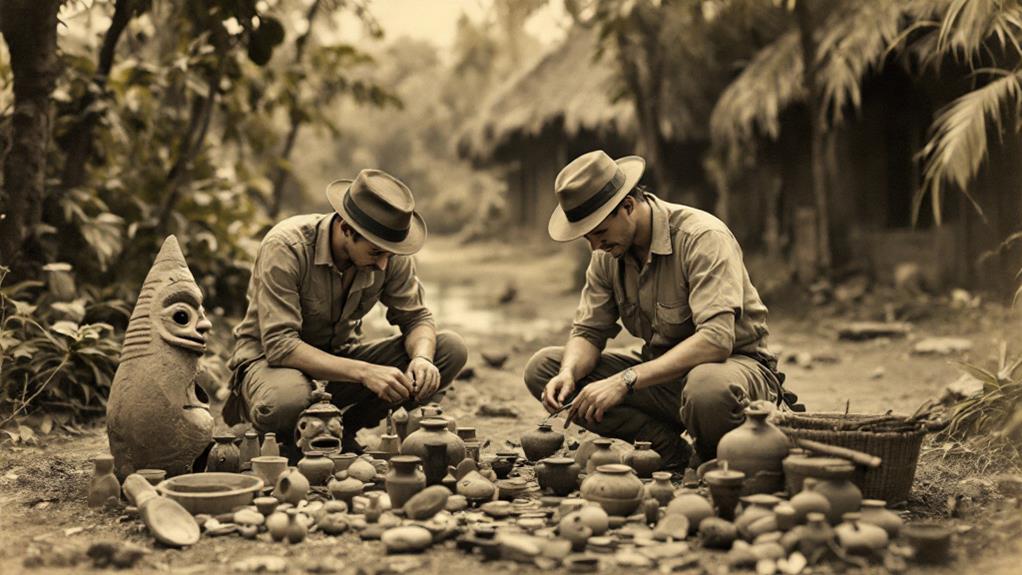The History of Archaeology: Uncovering the Past Through Excavation
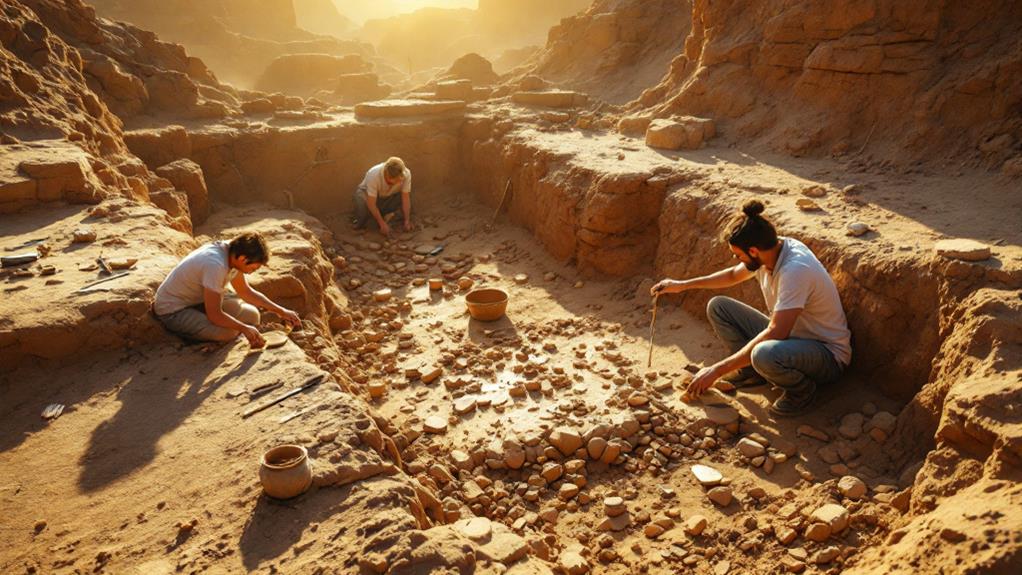
Archaeology has evolved from early antiquarian pursuits to a systematic scientific discipline. You'll find its roots in the fascination with ancient civilizations and the desire to collect artifacts. Modern archaeology emerged in the late 18th century, introducing careful documentation and stratigraphic excavation techniques. Iconic figures like Schliemann, who excavated Troy, and Carter, who uncovered Tutankhamun's tomb, pushed the field forward. Deciphering ancient scripts like hieroglyphs and cuneiform has revealed priceless historical observations. Today's archaeologists use advanced technologies like carbon dating, satellite imagery, and DNA analysis to uncover the secrets of our past. The expedition through archaeology's history is just beginning.
Early Antiquarian Pursuits
The roots of archaeology can be traced back to early antiquarian pursuits. You'll find that these initial forays into the study of ancient cultures were largely driven by personal fascination and the desire to collect artifacts. Wealthy individuals and scholars embarked on curiosity-driven explorations, often focusing on ancient civilizations like Greece, Rome, and Egypt.
As you immerse yourself deeper into this period, you'll notice that these early antiquarians weren't concerned with scientific methods or contextual understanding. Instead, they prioritized the acquisition of impressive objects for private collections formation. You'd see cabinets of curiosities filled with exotic artifacts, ancient sculptures, and mysterious relics.
While these early efforts lacked the systematic approach of modern archaeology, they played a pivotal role in sparking interest in the past. You can observe how this period laid the groundwork for future developments in the field. As you investigate further, you'll uncover that these antiquarian pursuits gradually evolved into more structured investigations, eventually leading to the establishment of archaeology as a scientific discipline.
Birth of Modern Archaeology
As antiquarian pursuits evolved, you'll notice a shift towards more systematic approaches in the late 18th and early 19th centuries, marking the birth of modern archaeology. This transition was characterized by a move away from haphazard amateur excavations towards more organized methods of investigation.
You'll find that early systematic surveys began to replace treasure hunting expeditions. Scholars started to document sites with great care, recording not just precious artifacts but also their context and relationships to other findings. This change in approach allowed for a more thorough understanding of past civilizations.
You'll see the emergence of stratigraphic excavation techniques, where archaeologists carefully remove and record layers of soil to reconstruct the chronology of a site. This method revolutionized the field, enabling more precise dating of artifacts and structures.
The birth of modern archaeology also saw the development of new tools and technologies. You'll observe the introduction of surveying instruments, photography, and detailed mapping techniques, all of which enhanced the accuracy and reliability of archaeological investigations.
This period laid the foundation for archaeology as a scientific discipline, setting the stage for future advancements in the field.
Schliemann and the Trojan War
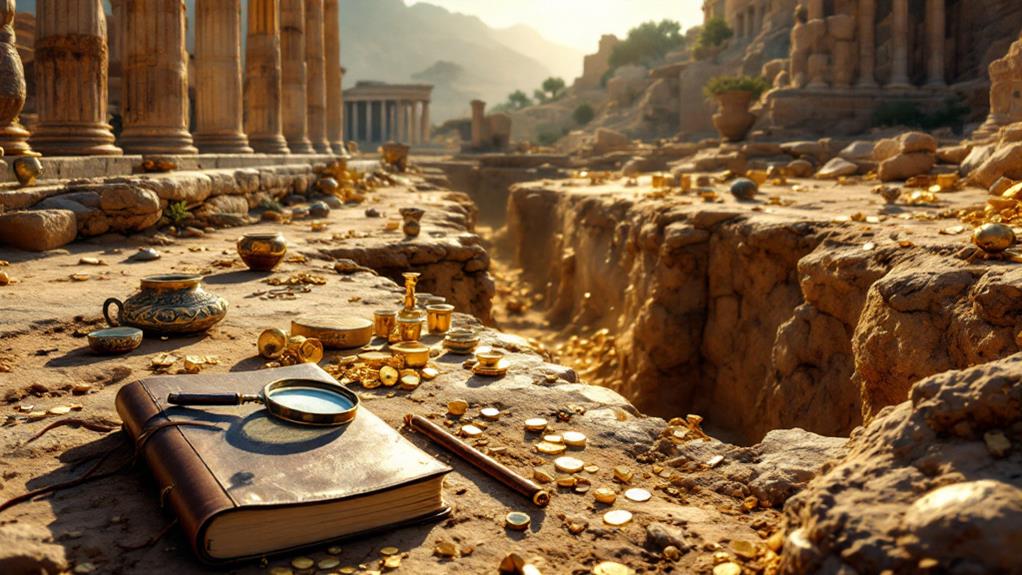
Driven by a lifelong fascination with Homer's epics, Heinrich Schliemann launched on a quest to prove the historical reality of the Trojan War. In 1870, he began excavations at Hisarlik, Turkey, believed to be the site of ancient Troy. Schliemann's troy excavation methodology was controversial, as he used dynamite and large-scale digging, often destroying upper layers to reach what he believed were older, more significant remains.
Despite his unorthodox methods, Schliemann uncovered exceptional artifacts, including a cache of gold and silver objects he dubbed "Priam's Treasure." These findings sparked intense debate about the trojan war archaeological evidence. While Schliemann's work was groundbreaking, modern archaeologists have since refined the chronology and interpretation of his discoveries.
You'll find that Schliemann's excavations at Troy marked a turning point in archaeology, popularizing the field and demonstrating its potential to uncover ancient texts. However, his hasty conclusions and destructive techniques also serve as a cautionary tale, highlighting the need for careful, systematic approaches in archaeological research. Today, Troy remains an active site of investigation, with ongoing excavations continuing to illuminate its complex history.
Egyptian Tombs and Treasures
Uncovering ancient Egyptian tombs and treasures has enthralled archaeologists and the public alike for centuries. You'll find that these discoveries have revolutionized our understanding of ancient Egyptian culture, religion, and daily life. The exploration of pharaohs' tombs, particularly in the Valley of the Kings, has revealed intricate mummification techniques and ancient burial practices that provide insight into Egyptian beliefs about the afterlife.
When you examine the treasures found in these tombs, you're looking at more than just valuable artifacts. Each object tells a story about the deceased's status, religious beliefs, and the society they lived in. The discovery of Tutankhamun's tomb in 1922 by Howard Carter is perhaps the most famous example, offering an unprecedented glimpse into the opulence of ancient Egyptian royalty.
As you investigate deeper into Egyptian archaeology, you'll encounter the challenges faced by excavators, from tomb robbers to environmental factors. Modern archaeologists use advanced technology to continue uncovering new sites and preserving existing ones, ensuring that future generations can learn from these remarkable remnants of an ancient civilization.
Deciphering Ancient Scripts
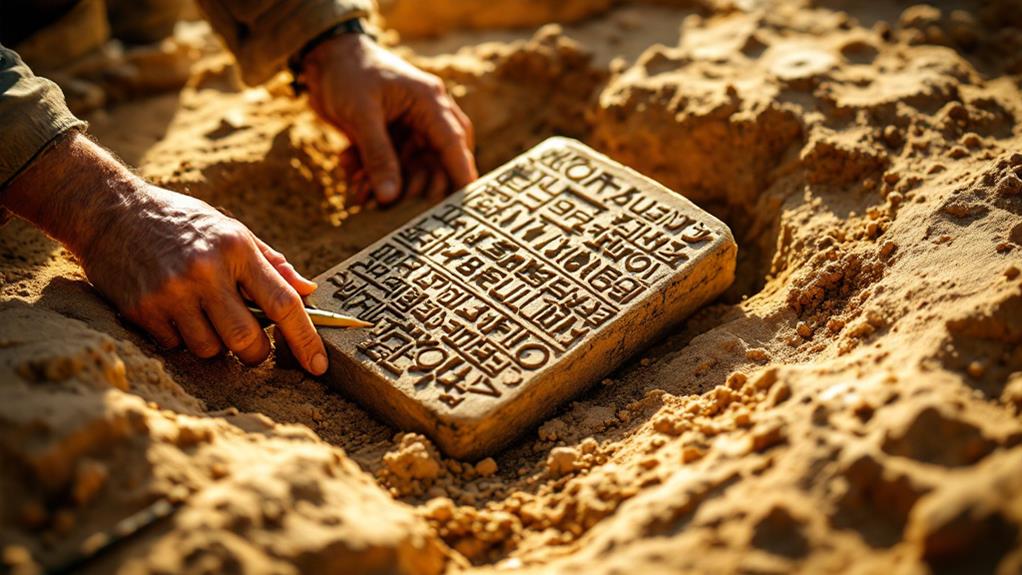
Throughout history, the ability to read ancient scripts has been indispensable for understanding lost civilizations. You've likely heard of the famous Rosetta Stone, which was key to deciphering Egyptian hieroglyphs. This breakthrough in 1822 by Jean-François Champollion opened up a wealth of knowledge about ancient Egyptian culture and history.
But hieroglyph translation isn't the only success story in decoding ancient writing. The cuneiform decipherment in the mid-19th century unraveled the secrets of Mesopotamian civilizations. You can thank scholars like Henry Rawlinson and Edward Hincks for their tireless efforts in cracking this complex system of wedge-shaped characters.
As you immerse yourself deeper into the world of ancient scripts, you'll find that each decipherment brings new challenges and rewards. From Linear B to Mayan glyphs, archaeologists and linguists continue to work together to uncover the mysteries of the past. These breakthroughs not only reveal historical facts but also provide a profound understanding into the daily lives, beliefs, and achievements of ancient peoples. The ongoing quest to decipher ancient scripts remains an integral part of archaeology's mission to comprehend our shared human history.
Underwater Archaeology
The depths of the world's oceans hold countless archaeological treasures waiting to be unearthed. Underwater archaeology has emerged as a vital field, allowing you to plunge into sunken cities, shipwrecks, and submerged artifacts. As you immerse yourself in this domain, you'll discover how scientists use advanced underwater mapping techniques to survey vast areas of the seafloor.
Remote sensing applications have revolutionized underwater archaeology. You'll find that sonar, magnetometers, and other cutting-edge tools help locate potential sites without disturbing the underwater environment. Once identified, these sites require careful excavation and preservation techniques to protect fragile artifacts from further deterioration.
You'll learn that underwater archaeologists face unique challenges, including limited visibility, strong currents, and the corrosive effects of saltwater. They must also contend with complex legal and ethical issues surrounding the ownership and preservation of underwater cultural heritage. Despite these obstacles, the field continues to yield remarkable discoveries, from ancient trade routes to lost civilizations. As technology advances, you can expect underwater archaeology to uncover even more secrets hidden beneath the waves, providing invaluable insights into human history and maritime cultures.
Carbon Dating and Chronology
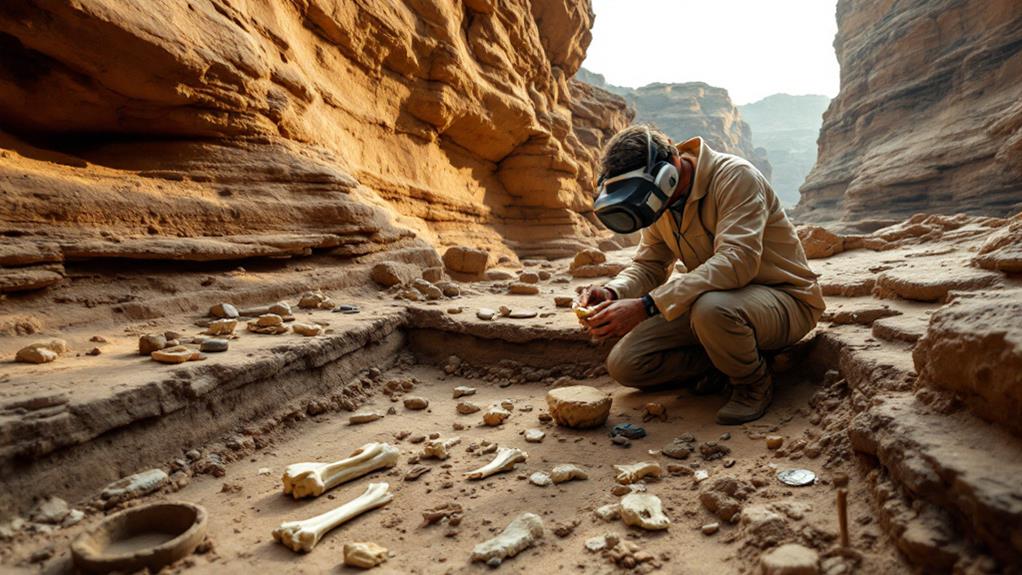
While underwater archaeology reveals hidden treasures, accurately dating these finds is paramount. That's where carbon dating and chronology come in. You'll find that these techniques revolutionized the field of archaeology, providing a more precise way to determine the age of artifacts and sites.
Carbon dating, also known as radiocarbon dating, allows you to estimate the age of organic materials up to about 50,000 years old. It's based on the decay of radioactive carbon-14 isotopes. You'll use this method to date items like wood, bone, and shells. However, it's not without limitations, as it can be affected by factors like contamination and changes in atmospheric carbon levels.
Stratigraphic dating methods, on the other hand, rely on the principle that older layers of soil are found beneath newer ones. You'll use this technique to establish relative chronologies at archaeological sites. By carefully excavating and documenting each layer, you can piece together a timeline of human activity and environmental changes.
Together, these dating techniques provide you with powerful tools to reveal the secrets of the past and build a more accurate representation of human history.
Satellite Imagery in Archaeology
From high above the Earth's surface, satellite imagery has revolutionized the field of archaeology. You can now survey vast landscapes and identify potential archaeological sites without setting foot on the ground. This technology has transformed how archaeologists conduct research, allowing them to detect subtle changes in vegetation, soil composition, and topography that may indicate hidden structures or artifacts.
Remote sensing techniques have become precious tools in your archaeological toolkit. You'll find that these methods can reveal features invisible to the naked eye, such as buried foundations or ancient road networks. By analyzing spectral data from different wavelengths, you can identify areas of interest that warrant further investigation.
Geospatial mapping applications have made it easier for you to integrate satellite imagery with other data sources. You can now create detailed maps that combine topographical information, historical records, and archaeological findings. This comprehensive approach allows you to better understand the spatial relationships between sites and their surrounding environments.
As satellite technology continues to advance, you'll have access to increasingly high-resolution images and more sophisticated analysis tools, further enhancing your ability to uncover and interpret the secrets of the past.
DNA Analysis of Ancient Remains
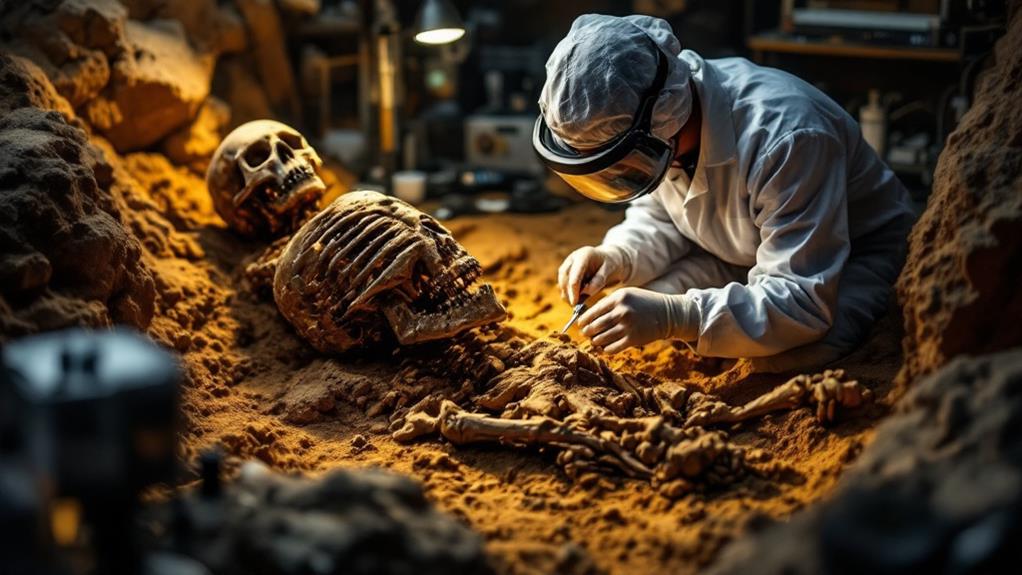
Disentangling the genetic code of ancient remains has opened up a new frontier in archaeology. You'll find that DNA analysis has revolutionized our understanding of human history, migration patterns, and evolutionary relationships. This powerful tool allows you to peer into the past with unparalleled clarity, revealing information about ancient populations that was previously inaccessible.
Through genetic genealogy, you can trace familial connections across vast spans of time and geography. You'll discover how different groups intermingled, migrated, and evolved over millennia. Bioinformatic techniques have greatly enhanced our ability to extract and interpret genetic data from even the most degraded samples.
You'll see how DNA analysis has challenged long-held assumptions about human origins and dispersal. It's revealed surprising connections between modern populations and their ancient ancestors, shedding light on historical events and cultural interactions. This technology has also helped identify remains, solving archaeological mysteries and providing closure to descendant communities.
As you explore deeper into the field, you'll find that DNA analysis continues to expand the horizons of archaeological research, offering new understandings into our shared human story.
Preserving Archaeological Heritage
In light of the ever-present threats to archaeological sites, preserving our shared heritage has become a critical concern in modern archaeology. You'll find that archaeologists today are not just focused on excavation but also on protecting and conserving the sites they uncover. This involves implementing sustainable site management practices and working closely with local communities to guarantee cultural sensitivity.
To effectively preserve archaeological heritage, you should ponder these key aspects:
- Documentation: Thoroughly record all findings using advanced technologies like 3D scanning and photogrammetry.
- Conservation: Apply appropriate techniques to stabilize and protect artifacts and structures from environmental factors.
- Education: Engage the public through outreach programs to cultivate appreciation and understanding of archaeological sites.
You'll notice that preserving archaeological heritage often requires a delicate balance between scientific research and respect for cultural beliefs. It's vital to involve local stakeholders in decision-making processes and to consider the long-term impacts of excavation and tourism on these irreplaceable resources. By adopting a comprehensive approach to preservation, you're not just safeguarding artifacts but also guaranteeing that future generations can continue to learn from and appreciate our shared human history.
